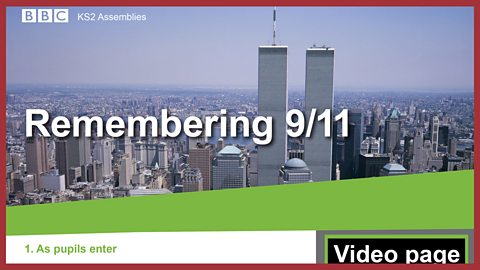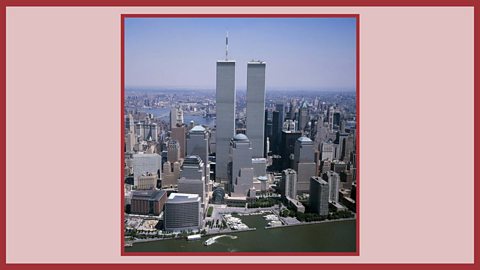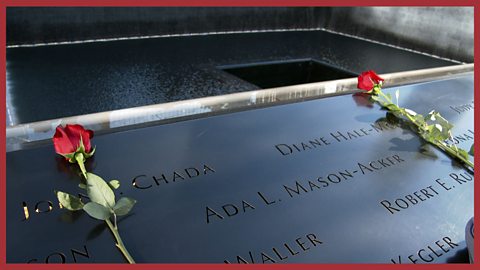In short...
Themes: The events of 11 September 2001 and their aftermath; tolerance; compassion.
Summary: This assembly considers the global significance of the events of 9/11 in a way that is appropriate for upper KS2 primary school pupils. It includes a specially-commissioned film and opportunities to reflect on the role we can all play in building a better world. It is particularly suitable each year as we approach the anniversary of the attacks.
Resources: The , a photograph of the as they were prior to the attack, a detail from the and a map showing the .

The video
The twin towers of the World Trade Center, New York City, prior to 11 September, 2001.
On September the 11th, 2001, the world stood stillβ¦and watched as a terrible event unfolded.
In a coordinated attack, four passenger planes were hijacked by a terrorist group called al-Qaeda, who planned to attack important landmarks in the United States.
The hijackers deliberately flew one of the planes into the Pentagon, a huge government building in Washington, DC.
Two more planes were flown into the famous twin towers of the World Trade Center - causing New York Cityβs two tallest skyscrapers to collapse.
It was a terrible criminal act that caused the deaths of nearly 3,000 people - including many brave first responders, who heroically gave their lives trying to rescue those trapped in the buildings.
The events that took place on September 11th came to be known simply as 9/11.
(Rudy Giuliani, Mayor of New York City in 2001, speaking in 2011) The impact of September 11 has to be profound on me. It was the worst experience of my life. It was the most devastating experience for my city, that I was responsible for. This is unlike anything that we've ever seen before in New York City or anything we ever handled before and we had handled everything. This was so far beyond anything that we had contemplated.
The impact of 9/11 was huge. The families and loved ones of the people who lost their lives suffered enormous grief. And it took nearly nine months and the work of many thousands of people to clean up the wreckage from the fallen towers.
But 9/11 didnβt just change the lives of those directly affected. It impacted everybody. And even though it happened a long time ago, it still affects our lives today.
After the attacks, George W Bush - the President of the US at the time - declared a βWar on terrorβ, targeting the extremist groups that arranged the attacks. And US allies, including the UK, became involved in conflicts in Iraq and Afghanistan - two countries whose governments were assumed to be sympathetic to the terroristsβ cause.
To prevent a similar attack from happening, airport security everywhere became a lot more strict.
And even though 9/11 was carried out by an Islamist terrorist group, whose victims included people from all backgrounds, including Muslims, some people wrongly started to blame all Muslim people for the attacks, which lead to a rise of violence and prejudice against Muslim people - called Islamophobia - which continues to impact the lives of Muslim people all around the world.
Today, New Yorkβs skyline looks very different. After the attacks, a taller, single tower was built in memory of the fallen twin towers at the site of the event - called One, World Trade Center. And a beautiful memorial and a museum has been built too, where people can pay respects and learn about the event.
Every year on the anniversary of 9/11, special memorials take place at the sites of the attacks. And on the night of September 11th, two beautiful beams of light - representing the twin towers - are projected into the sky above New York City. They can be seen from more than 100km away.
Itβs important to remember events like 9/11, not just to commemorate the people who lost their lives. But to remember the compassion and bravery that brought people from all over the world together, to support and help each other in the face of great tragedy.
By understanding the importance of tolerance and respect, we can all build a more peaceful world and make sure that events like 9/11 never happen again.
(New Yorker, speaking on anniversary of the attacks) It's a sad day still. And, you know, just wishing love and peace and hoping nothing like this ever has to happen again. And it's sad, sad that it continues to happen, so really hoping that our world becomes a more peaceful, better place to live.
Note: the video does not include any pictures showing the moment of the attack on the World Trade Center or of the twin towers collapsing.
On 11 September 2001 four passenger aircraft were hijacked in the skies above the eastern United States by al-Qaeda terrorists. Two of the planes were flown into the twin towers of the World Trade Center in New York City, causing both to collapse; a third was flown into the Pentagon - the headquarters of the US military; the fourth crashed in a field in Pennsylvania, following resistance from passengers onboard. In all about 3,000 people were killed, including about 300 firefighters and other emergency workers at the World Trade Center.
Following the attacks President George W Bush announced a 'war on terror'. The al-Qaeda terror group and its leader, Osama bin Laden, were believed to be operating from Afghanistan, sheltered by the Taliban - a religious/military organisation that had seized control of the country in 1996. The Taliban refused to hand over bin Laden and military conflict followed. By December 2001 Afghanistan was in the control of the US and its allies, including the UK, and the Taliban and al-Qaeda were forced to either flee or go into hiding.
In 2003 US and British troops invaded Iraq, another country whose leaders were considered sympathetic to the terrorists' cause, leading to the downfall of Saddam Hussein's regime.
In Afghanistan attacks by the Taliban against US, British and Afghan forces gradually escalated in the years following 2001. In the years 2012 to 2021 successive US administrations released plans to withdraw US troops and peace talks were held between the Taliban and the US and Afghan governments. In April 2021 Joe Biden, the fourth US president in power during the conflict, set 31 August 2021 as the date for the final withdrawal of US forces - ahead of the twentieth anniversary of the 9/11 attacks.
However, with the US and its allies engaged in withdrawal, the Taliban swiftly regained control of the country in August 2021. While the Taliban began arrangements for a new government many Afghans fled to the country's main airport hoping to be evacuated alongside US, British and other foreign nationals. The last US troops left shortly before midnight on 30 August - leaving the country once again in the hands of the Taliban and the Afghan people facing an uncertain future.
NB: Rudi Giuliani, who features briefly in this film, was Mayor of New York City from 1994 to 2001, including at the time of the attack on the World Trade Center. In 2018 Giuliani became part of Donald Trump's legal team. On 14 August 2023 he was indicted in relation to the 2020 election in the state of Georgia and was subsequently arrested on 23 August 2023.
Duration: 5' 01". The final words are: 'β¦hoping that our world becomes a peaceful, better place to live.'
Video questions
- On what day did the events of 9/11 take place? (11 September 2001)
- Which buildings were targeted that we hear about in the film? (The twin towers of the World Trade Center in New York City and the Pentagon near the capital city, Washington DC)
- About how many people were killed in the attacks? (3,000 - the vast majority in New York City)
- What did President George W Bush do after the attacks? (He declared a 'war on terror')
- Which two countries were invaded by the US and its allies after the attacks? (Afghanistan and Iraq)
- What is 'Islamophobia'? (Prejudice against Muslims, based on religion)
- What can be found at the site of the World Trade Center attack today? (A new, single tower; a museum and memorial)
- What happens in New York City each year to commemorate 9/11? (Two beams of light, representing the twin towers, are projected into the night sky).

Key links
Download / print the assembly framework ready for use

Click to display the image full-size

Click to display the image full-size


Suggested framework
1. Entry
You could play a solemn piece of music such as Samuel Barber's Adagio for Strings which is often used during commemorations of 9/11.
2. Introduction
Tell the children that they will be finding out about the events that took place in the United States of America on 11 September 2001. Explain that this day is now widely referred to as '9/11' - because in the US it is customary to write the date with the month before the day. (You may also wish to share that in the US 'centre' is spelled 'center'). Explain that the things that happened on this day affected people not just in the US but all around the world - and they continue to affect us today and have been in the news recently. Ask everyone to think about the immediate and long-term effects of 9/11 as they watch the video.
3. The video
Play the video. The duration is 5' 01" and the final words are: 'β¦hoping that our world becomes a peaceful, better place to live.'
4. After the video - Time to talk
Begin with some questions to help children consolidate their understanding of the events of 9/11:
- Who can tell me what happened on 11 September 2001? (Hijacked planes were flown into US landmarks, including the twin towers of the World Trade Center, causing them to collapse).
- Who was directly affected by the events of 9/11? (The approx 3000 people who died - including many emergency workers; their families; their friends).
- How have the events of 9/11 affected people around the world? (Increased security - especially at airports; Muslim people in many western countries have experienced 'Islamophobia', including violence and discrimination; two countries - Afghanistan and Iraq - were invaded in order to effect 'regime change').
- What can now be found at the site of the attacks in New York City? (A memorial, a museum, a new tower, beams of light projected in the sky on the anniversary of the attacks). Wait for responses. Follow up with What do you think is the main message of the 9/11 memorial? (To remember those who died, and to encourage compassion and tolerance to avoid events like this from happening again).
Then tell everyone: Turn to the person next to you and ask them: 'How would you have felt if you were watching the news as these events happened on 11 September 2001?'
5. Opportunity to sing
You could include a song here - suggestions from ΒιΆΉΤΌΕΔ collections below.
6. Opportunity to reflect
Focus your reflection on the people who came together to help each other after the terrible events of 9/11. Ask the children to sit quietly and think about how they can help their friends and family after something bad happens, just by being kind and by being tolerant of other peopleβs views. By showing compassion and tolerance we can all help to make the world a more peaceful place and try to make sure events like 9/11 do not happen again.
7. Opportunity for prayer
Begin with your usual form of address and:
We remember all the people who lost their lives on 11 September 2001.
We thank you for the bravery of those people who risked their lives for others on that day.
Help us to understand that we all have a role in shaping the futureβ¦and that by showing compassion and tolerance we can all help to build a more peaceful world.
Amen.

Suggested songs
Song: 'Being a friend' (All about our school, no 8. Vocal version)
Being a friend is the best thing you can be,
β¨βCos in the end friends are something we all need.
You could score a goal for England,β¨
Be a pop star on TV,
β¨But being a friendβ¨
Is still the best thing you can ever be.
Being a friend is the best thing you can do,β¨
Time and again itβs our friends that help us through.
You could be a millionaire,β¨
Or fly a rocket to the moon,
β¨But being a friendβ¨
Is still the best thing you can ever do.
Whatever we grow up to be,
And live in harmony,
Together we all need to see
That friendship is the key!
Being a friend is the best thing you can be,β¨
βCos in the end friends are something we all need.
You could score a goal for England,
β¨Be a pop star on TV,β¨
But being a friendβ¨
Is still the best thing you can ever be.
Being a friend
β¨Is still the best thing you can ever be.
'Build up' (All about our school, no 12)
Verse 1:
Every word you say, (wo-oh)
Every game you play, (wo-oh)
Every silly face, (wo-oh)
Every single place, (wo-oh)
You can build up,
spoken 1, 2, 3, 4, 5!
Or you can tear down.
Chorus:
Build up one another,
Build up your sisters and brothers,
Build up one another,
Build up!
Verse 2:
Every joke you tell, (wo-oh)
Every name you spell, (wo-oh)
Everywhere you go, (wo-oh)
Everyone you know, (wo-oh)
You can build up,
spoken 1, 2, 3, 4, 5!
Or you can tear down.
Chorus:
Build up one another,
Build up your sisters and brothers,
Build up one another,
Build up!
Build up!
Build up!
'Together' (All about our school, no 13).
- Work together, not alone,
Gather round and share a problem.
Work together, hand in hand,
Gather round and work things out.
Chorus
βCos together, we can work it out together,
We can ride the stormy weather,
As long as weβre together weβre strong!
- Thereβs a setback, donβt despair,
Gather round and share your feelings.
Why just worry on your own?
Gather round and work things out.
Chorus
- If thereβs trouble big or small,
Gather round and find an answer.
If you stumble thereβs a friend,
Gather round and work things out.
Chorus

Related links
- CΒιΆΉΤΌΕΔ Newsround: What happend on 11 September 2001?
- CΒιΆΉΤΌΕΔ Newsround: The legacy of 9/11
- Resources for Key Stage 2
